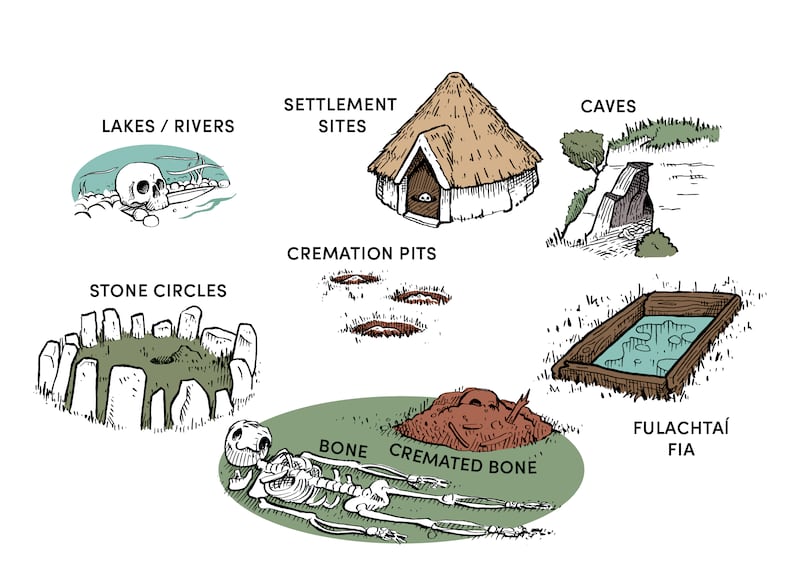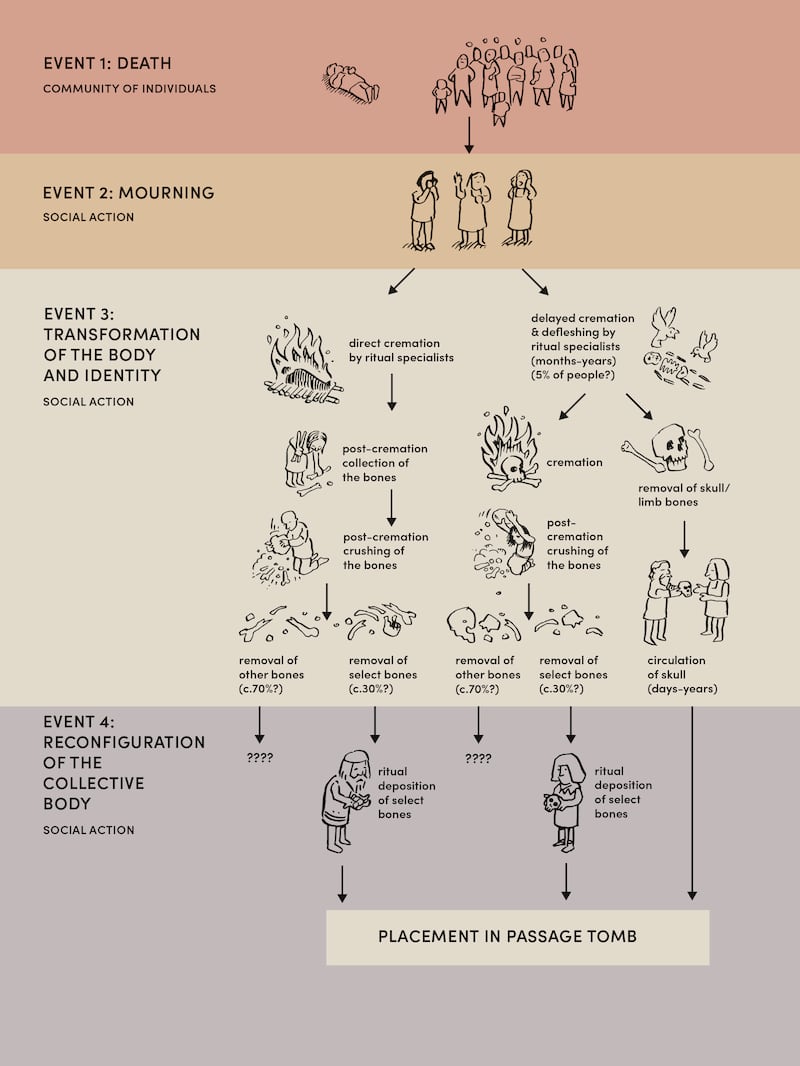Archaeologists talk about reconstructing “life in the past”. The stark reality, however, is that death is just as constant, central and important to society as life. Irish society is noted for having an ability to deal with the dead, evidenced by the centrality of the funeral in Ireland. Curiously, however, the wider social role of death in modern Irish society remains under-examined. Today, we tend to see death as both personal and distant: usually confronted in the case of the demise of family members, friends or ourselves, or brought into focus by warfare, accidents or events with a high death toll, such as the Covid-19 epidemic. Recognition of our mortality is central to being human, and that has been the way over the 10,000 years of definite human presence on the island of Ireland.
In these 10,000 years only the most recent 1,500 years are recorded historically; before that we rely on the archaeological record of material remains to document people’s lives and deaths. Although we do not know how the majority of people in the deep past in Ireland were treated at their death, we know a lot about how a minority of the dead were looked after – because their postmortem treatment was important to the living and was central to the social worlds they created. While there was a diversity of approaches to dealing with death in Irish prehistory, three overarching themes – people, place and practice – emerge from a review of these existential issues that might be helpful in reflecting on how we deal with death today.
Tomás Ó Carragáin of University College Cork (UCC) suggests that it is only with the emergence of Christian community cemeteries from the late first millennium AD that the burial places of a majority of the population become visible. Before that, the people whose postmortem treatment we have evidence for are those who were regarded as socially significant. This provides an interesting parallel with those whose deaths receive wider social notice today. In earlier times, socially significant people were not just archetypical males but included adults, adolescents and children from kin or lineage-based groups. Mortuary treatment often involved the placement of objects with them. Reflecting on the way simple things today can take on a special meaning because they are linked with someone important to us who has died is a reminder to us as archaeologists not just to focus on high-quality “grave goods” that were placed with the remains of the dead. Relationships and links might be expressed in a range of materials, mundane and special, within and beyond the grave.

This brings us to a second recurring motif: the repetition of burial at particular locations over long periods of time – as much as over a millennium – and many generations, in very different social contexts. In rural Ireland today it is still common for people to be buried in graveyards that have been in use since medieval or even early medieval times. Why were particular places returned to? What brought about reuse, renewed deposition? Phases of activity may mark specific occasions or social changes and cycles of activity; this has been suggested for use of megalithic tombs from 3,700 BC and early Bronze Age cemeteries from 2,100 BC. A sense of continuity can mask long periods when locations fell out of use, or it can take the form of “invented traditions” that signify the linking of new social groups to particular places, land or territory. In either case it is a striking demonstration of the power and attraction of particular places or cemeteries in mortuary practice. As Thomas Lynch put it in The Undertaking: Life Studies from the Dismal Trade, graveyards are “old arrangements between the living and the living who have died”.
READ MORE
In relation to our third motif, many aspects of prehistoric mortuary practice appear different from those of today. They involved several stages, took place over a considerable period of time and were staged in different locations. The primary postmortem treatment of the body – initial burial – often took place at a different location from where individual bones disarticulated or separated from the skeleton were finally deposited. Mention of the deposition of some of the remains raises the issue of what happened to the rest of that person’s remains? At times body parts, particularly skulls, were in circulation – in active use by the living. There are repeated instances of skulls being treated in a different way to the rest of the body after death, or ending up in different locations. The late Celtic scholar Barry Raftery made the point that the cult of the head was widespread in all areas of Celtic Europe. The head was seen as the seat of the soul, the essence of human personality, and so could come to represent a deity. This focus on skull deposits is echoed in Ireland.

Likewise, the deposition of cremated remains was often not at the site of the cremation pyre where the body was burnt after death. Burnt bones and other material, including objects placed with the dead on the pyre, were collected after cremation and brought to what was considered a suitable location for burial. We see a further complex stage in postmortem practice in the communal cremation deposits characteristic of passage tombs, such as at the Mound of the Hostages at Tara, where cremated and unburnt remains of different individuals are deposited together. This seems very different from how we treat dead bodies today, but it was a response to a human need in a specific cultural context, to understand what was going to happen next – both to the dead and to the living left behind.
There was diversity in mortuary practice within any given period of prehistory, and mortuary practices also changed over time. All of this reflects the complex roles of the dead within kin and relational identities in small-scale societies. It also mirrors a belief that after the transition of death, the physical remains and memory of the dead continue to have a social relevance, something that still holds true today. Indeed, it is often said that we finally die only when our name is spoken for the last time. In most, if not all, small-scale societies death is viewed as a transition to some other state. It is understood that the dead will continue to have an impact on and a relationship with the living. This is why the treatment of the dead was and is important; they continue to be related to and relevant for the living.
[ How to go on an archaeological dig: Be patient – it’s not all Indiana JonesOpens in new window ]
Living in the Anthropocene and facing a climate emergency, when we need to adapt to new ways of life, it is important to reflect on how people in the past lived and died, how they faced significant environmental changes. Above all, we have to recognise and come to terms with, as Rachel Clarke put it in Dear Life: A Doctor’s Story of Love and Loss, “the ubiquitous business of dying”. Archaeologists have the privilege of coming to face to face with dead people from the past, providing the possibility of writing them back in to history and reminding us of our shared humanity, in life and death.
Gabriel Cooney is emeritus Professor of Celtic Archaeology at University College Dublin. Death in Irish Prehistory, with illustrations by Conor McHale, is published by the Royal Irish Academy













